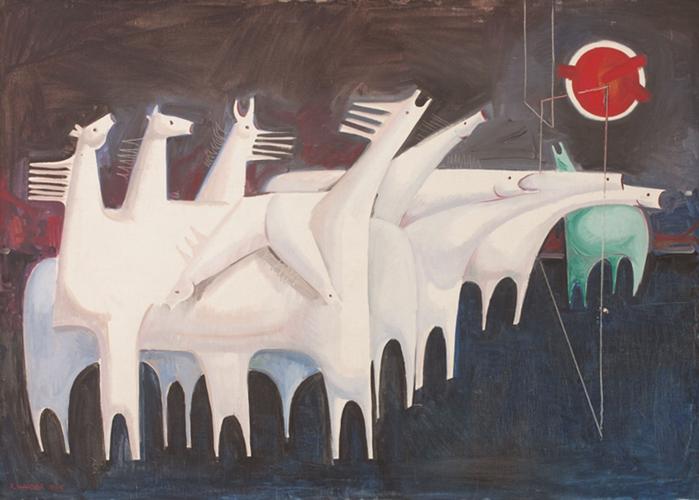The Battle of Karbala was fought in the year AD 680 in what is now present-day Iraq. The incident came about after Husayn ibn Ali, a grandson of the prophet Muhammad, refused to swear allegiance to the caliph Yazid I. Husayn, along with his family and supporters, were ambushed near the Euphrates by Yazid’s military. Those supporters who weren’t killed were imprisoned, but most — including Husayn, who was beheaded — were slaughtered, trampled under the hooves of the soldiers’ horses. The victims have since been considered martyrs among many Sunni and Shia Muslims, their sacrifice commemorated by religious observances as well as in histories, literature, and art.
More than a millennium on, artist Kadhim Hayder (1932-1985) referenced the Battle of Karbala in his 1965 painting Fatigued Ten Horses Converse With Nothing, also called The Martyr’s Epic, a work that questions martyrdom’s value and despairs at the lack of answers to those questions. The Martyr’s Epic is now among many other treasures in the collection of the Barjeel Art Foundation, a museum established in 2010 in the United Arab Emirates to house the art collection of Sultan Sooud Al-Qassemi. The collection’s focus is on modern and contemporary Arab art. In 2015, London’s Whitechapel Gallery hosted a four-part exhibition based around the Barjeel collection and published an accompanying catalog, Imperfect Chronology: Arab Art From the Modern to the Contemporary. The catalog is an overview that places the art movements of the Middle East within the context of changing traditions, war, diasporas, and political upheavals. The introduction by Whitechapel director Iwona Blazwick states that a barjeel is an ancient type of cooling tower common to the Middle East. The name means “wind-catcher,” and as she writes, “It seems a particularly apposite description for a collection of art that spans a seismic century of cultural expression.”
The horses in The Martyr’s Epic cry out as though in sorrow, under a dark sky and a blood-red sun. The painting has an antecedent in Pablo Picasso’s Guernica. Like Picasso’s painting, which was made in response to the bombing of the Spanish village by Nazis during World War II, the lack of reference in The Martyr’s Epic to specific events beyond the Battle of Karbala makes it a timeless symbol of oppression, suggesting that the lessons of the past have yet to be learned. According to Omar Kholeif, former curator at Whitechapel Gallery, white horses often represent martyrs in Islamic culture.





